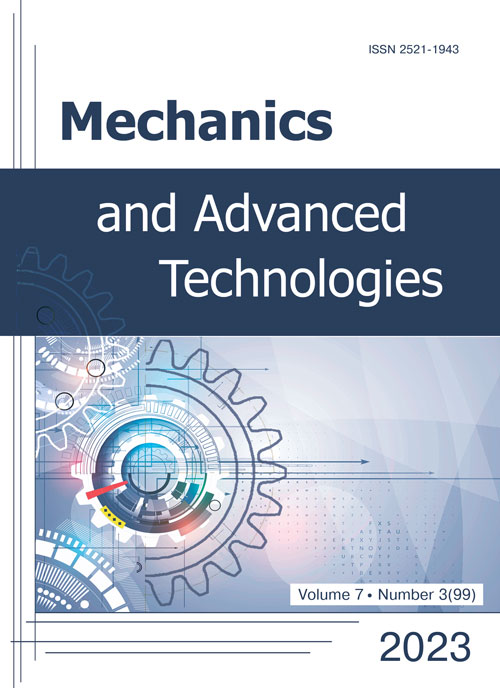Analysis of the influence parameters on steel strip defects in continuous roll casting-rolling
DOI:
https://doi.org/10.20535/2521-1943.2023.7.3.292694Keywords:
roll casting-rolling, casting, rolling, squeeze, reverse speed, rolling effortAbstract
Problem. The casting-rolling process is currently one of the most effective and promising processes used for the production of steel sheets. The advantages of this process include the small dimensions of the unit and a significant reduction in energy resources. This occurs due to a combination of technological operations and absence of the intermediate heating of the metal. At the same time, there is the challenge of a sustainable industrial process for producing high quality steel sheets.
Objective. Companies developing direct melt strip processes using twin-roll crystallizers report a number of challenges they face. Among such problems are defects on the surface of the cast strip. Currently, there is no generally accepted classification of surface defects, such as surface cracks, wrinkles, namely, depressions, and transverse deformation bands. At the moment, there is also no justification for the reasons for the appearance of surface defects during the rolling process.
Implementation methodology. Based on the research results, a hypothesis was proposed about the causes of defects on the surface of the cast strip and ways to prevent them. During the operation of two-roll crystallizers, a combination of metal hardening processes and its subsequent plastic deformation occurs. The metal moves sequentially through areas of crystallization and deformation. During the research, the authors calculated the process of roll casting-rolling.
Conclusions. Based on the research results, we believe that when casting steel using twin-roll casting-rolling, it is necessary to reduce the compression to a minimum value. This recommendation will ensure welding of defects on the surface. The use of this proposal will allow the casting process to be carried out at high speed and little force to be applied to squeeze the rolls. We propose to carry out the process of forming a cast strip with the necessary quality parameters at the following stages of rolling.
References
- K. Shibuya and M. Ozawa, “Strip Casting Techniques for Steel”, ISIJ International, vol. 31, no. 7, pp. 661–668, 1991. DOI: https://doi.org/10.2355/isijinternational.31.661.
- A. R. Buchner and H. Zimmermann, “Cracking phenomena in twin roll strip casting of steel”, Steel Research, vol. 73, no. 8, pp. 327–331, 2002. DOI: https://doi.org/10.1002/srin.200200217.
- D.-K. Choo, H.-K. Moon, T. Kang and S. Lee, “Analysis and prevention of cracking during strip casting of AISI 304 stainless steel”, Metallurgical and Materials Transactions A, vol. 32, no. 9, pp. 2249–2258, 2001. DOI: https://doi.org/10.1007/s11661-001-0200-0.
- О. Kholiavik, O. Nogovitsyn, O. Kravchuk, O. Samoilenko and R. Boris, “Rheological characteristics of steel in continuous roll casting-rolling”, Mech. Adv. Technol., vol. 5, no. 3, pp. 381–387, Dec. 2021. DOI: https://doi.org/10.20535/2521-1943.2021.5.3.250182.
- M. Ha, J. Choi, S. Jeong, H. Moon, T. Kang and S. Lee, “Analysis and prevention of microcracking phenomenon occurring during strip casting of an AISI 304 stainless steel”, Metallurgical and Materials Transactions A, vol. 33, no. 5, pp. 1487–1497, 2002. DOI: https://doi.org/10.1007/s11661-002-0071-z.
- T. Mizoguchi, K. Miyazawa and Y. Ueshima, “Effect of Casting Atmosphere on the Formation of Strip Surface in Twin Roll Casting Process”, Tetsu-To-Hagane, vol. 80, no. 1, pp. 36–42, 1994. DOI: https://doi.org/10.2355/tetsutohagane1955.80.1_36.
- S. Tanaka, I. Suichi, S. Ogawa, T. Furuya, K. Sasaki and K. Yanagi, Steelmaking Conference Proceedings. Washington: Iron and Steel Society, 1991.
- H. Yasunaka, K. Taniguchi, M. Kokita and T. Inoue, “Surface Quality of Stainless Steel Type 304 Cast by Twin-roll Type Strip Caster”, ISIJ International, vol. 35, no. 6, pp. 784–789, 1995. DOI: https://doi.org/10.2355/isijinternational.35.784.
- T. Mizoguchi, K. Miyazawa and Y. Ueshima, “Relation between Surface Quality of Cast Strips and Meniscus Profile of Molten Pool in the Twin Roll Casting Process”, ISIJ International, vol. 36, no. 4, pp. 417–423, 1996. DOI: https://doi.org/10.2355/isijinternational.36.417.
- R. P. Tavares and R. I. L. Guthrie, “Computational fluid dynamics applied to twin-roll casting”, Canadian Metallurgical Quarterly, vol. 37, no. 3–4, pp. 241–250, 1998. DOI: https://doi.org/10.1016/S0008-4433(98)00011-1.
- A. Girgensohn, A. R. Buchner and K.-H. Tacke, “Twin roll strip casting of low carbon steels”, Ironmaking & Steelmaking, vol. 27, no. 4, pp. 317-323, 2000. DOI: https://doi.org/10.1179/030192300677615.
- Sa Ge, M. Isac and R. I. L. Guthrie, “Progress in Strip Casting Technologies for Steel; Technical Developments”, ISIJ International, vol. 53, no. 5, pp. 729–742, 2013. DOI: https://doi.org/10.2355/isijinternational.53.729.
- Yu. Ya. Skok, V. L. Naydek, R. Ya. Yakobshe et al, “Analysis of steel duct dips at high temperatures”, Protsessy litya, no. 4, pp. 56–61, 2002.
- Yu. V. Konovalov, A. L. Ostapenko and V. I. Ponomarev, Calculation of sheet rolling parameters. Moscow: Metallurgiya, 1986, 430 p.
- О. V. Nogovitsyn, І. А. Nuradinov and D. О. Petrenko, “To the question of the appearance of defects on the surface of the steel staff during roll casting”, Metal and Casting of Ukraine, vol. 28, no. 3 (322), pp. 33–39, 2020.
Downloads
Published
How to Cite
Issue
Section
License
Copyright (c) 2023 Олексій Ноговіцин, Ольга Холявік, Руслан Борис, Дмитро Сохан, Наталія Семінська

This work is licensed under a Creative Commons Attribution 4.0 International License.
Authors who publish with this journal agree to the following terms:
- Authors retain copyright and grant the journal right of first publication with the work simultaneously licensed under CC BY 4.0 that allows others to share the work with an acknowledgement of the work's authorship and initial publication in this journal.
- Authors are able to enter into separate, additional contractual arrangements for the non-exclusive distribution of the journal's published version of the work (e.g., post it to an institutional repository or publish it in a book), with an acknowledgement of its initial publication in this journal.
- Authors are permitted and encouraged to post their work online (e.g., in institutional repositories or on their website) prior to and during the submission process, as it can lead to productive exchanges, as well as earlier and greater citation of published work











